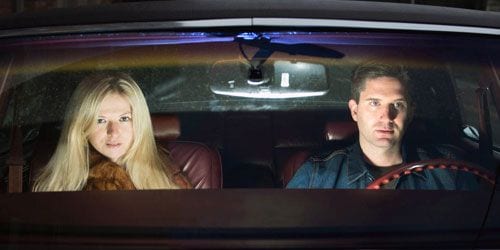
Though 2013 has yet to reach its halfway mark, any group operating in the indie dream-pop realm already has their work cut out for them in releasing an album that will top Strange Pleasures, the sophomore LP from London duo Still Corners. Across the record’s 12 tracks, multi-instrumentalist Greg Hughes and vocalist Tessa Murray present some of the most evocative and melodious tunes to arise from the subgenre in recent memory. In line with the form’s staples, the music is ephemeral, but not meandering, the lush arrangements striking a balance between organic instrumentation and the synthetic, the crystalline guitar lines offsetting digital pop effects and subdued drum machine beats.
The music throughout the piece is weightless, lilting to and fro, shimmering and rippling from outset to conclusion. An ethereal quality permeates the record; with a set of good headphones on, the music seems to levitate and wrap around you, the cover art’s juxtaposition of desert sands and clouds, of bright reds and blues, informing the sensation. The contrasting colors likewise mimic the ambivalence between the song’s alternating cool and warm moods. In a synesthesia-type manner, the music nearly elicits the feeling of sensing colors, of each note composing a vivid nebula.
As the architect of the piece, Hughes is to credit for this, his multifaceted guitar playing and Murray’s voice being the scaffolding on which the songs are built. Hughes made a wise choice in selecting Murray as his vocalist, as her voice is itself a mellifluous instrument. Similar in its whispery breathiness to the likes of Hope Sandoval, Bilinda Butcher and Margo Timmins, it is far clearer than any of those, though no less haunting. Murray does not obscure Hughes’ lyrics as she sings them, as a result emoting in more definable ways, opting to use the space between verses to let her layered voice soar wordlessly as a siren’s beckoning.
In terms of subject matter, the album is dominated by concerns of wanderlust and transience. This theme of travel and venturing forth is presented with opener “The Trip”. The tune opens with the delicate pluck of what could be harp strings, segueing into acoustic guitar strumming which comes to serve as the song’s steady rhythm. Soon enough, arpeggio electric guitar playing emerges as the first couplet finds Murray addressing the topic directly: “Time has come to go / Pack your bags, hit the open road.” Road-weariness is palpable, the chugging acoustics standing as the monotony of watching lines on the pavement whip by, the individual notes of the western-tinged guitar being the unique roadside sights, Murray reciting the simple chorus of “So many miles / So many miles / Away.” Towards the end, Hughes shifts his playing to a rolling solo, seemingly to convey that it’s the travel itself, not the destination, that matters. Later on the record, the flipside of going on an aimless adventure, that being of returning to a refuge after spending time abroad, is offered with “Going Back to Strange”. Sentimental but not overly so, it is one of the most minimal tracks on the record, mostly acoustic guitar plucking, sparse piano notes and Murray’s hushed voice, some background ambience there for atmosphere. “I’m so close to the light / I can see the house from here / I got some crazy on my mind / Oh, my heart belongs here,” Murray sings, and anyone who left home in defiance only to have nostalgia lead you back can empathize.
The idea of enjoying the present moment in the face of impermanence is most acute in lead single “Fireflies”. “Long gone days / Catch ‘em while you can / Everyone wants to fly with the fireflies,” Murray sings, adding later, “We’ll stay as long as we like / Days of our youth lost in the firelight,” the darting rhythm evoking youthful memories of trying to catch the flickering luminescent bugs. While acknowledging the fleeting nature of existence is advocated, it is not treated as an easy task, as seen in the down-tempo romanticism of “I Can’t Sleep”. Here, Murray declares her dependence on another, reciting as a mantra “Don’t know if I can sleep without you” amid an expansive musical backdrop that pans like a searchlight. “All I Know” follows “I Can’t Sleep”, however, brushing away the insecurity of the previous tune in its advice to cherish the here and now, not the once was. “Fire / In the summer,” Murray sings atop instrumentation fluttering like insect wings, the sunset of a summer day conjured in your mind’s eye.
Near the midpoint of the record, the flow lags a bit. Starting with the Krautrock, and in that sense, aptly named, “Berlin Lovers” and continuing through the quasi-dance beats of “Beatcity”, the album tends to sputter rather than soar (excepting “Going Back to Strange”, which is placed in this group). Thankfully, the record regains its footing with “Midnight Drive”, which, as the title implies, again references the theme of release via travel. The nocturnal name is matched by the music, surging in the subtlest ways, bubbling up with determination and an undercurrent of menace. Murray is at her most spectral here, the epitome of sultry as she coos, “I know, I know / We’re lost / I can’t help myself / When we drive / It don’t hold us back / This midnight drive.” The two successive songs, “We Killed the Moonlight” and the title track, wrap the album on a high note, the latter in particular mesmerizing in its heavy synth patterns.
In 2012, Still Corners’ labelmates Beach House received much deserved critical lauding for the dream-pop masterwork Bloom. In the unlikely event something better comes along in the next seven months, Strange Pleasures deserves to inherit Bloom’s mantle. The most baffling incongruity of the record is its name, for there is nothing strange about the pleasures it offers; they are of the most immediate and rewarding variety.

![Call for Papers: All Things Reconsidered [MUSIC] May-August 2024](https://www.popmatters.com/wp-content/uploads/2024/04/all-things-reconsidered-call-music-may-2024-720x380.jpg)



